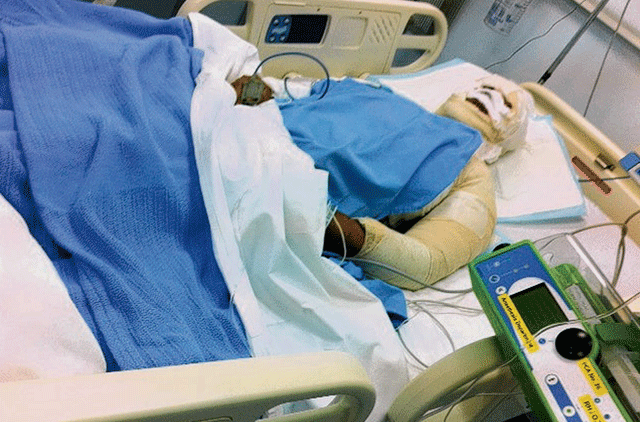
Dubai: It was a horrific accident waiting to happen.
Last year, Neelaakshi Sewwandi, a 22-year-old housewife living in the Karama area of Dubai, suffered horrific burns when a drain-cleaning liquid sitting atop her fridge fell and spilled on her face and body as she opened the refrigerator.
Within minutes the highly corrosive drain cleaning liquid had eaten into her skin and reached her bones and she was rushed to Rashid Hospital with third degree burns to her face, shoulder and scalp.
The drain cleaner, which she and her husband Prasad had purchased from a shop in Satwa, had been placed on the refrigerator to keep it away from their 10-month-old son, Deneth.
Many of us stock such innocuous looking cleaning agents at home — drain decloggers, bleach, aerosol air fresheners, disinfectants, sprays, naphthalene balls, metal polishes — many of which pose serious health hazards. The result — our homes which should be our safest sanctuary have been converted into death dens thanks to these hazardous chemicals so easily available at all supermarkets.
Surprisingly, there is a fair level of ignorance on this issue.
Few of us really bother to read the list of ingredients in the fine print and more often than not they contain hazardous chemical compounds including Volatile Organic compounds (VOCs) that are corrosive and trigger eye irritation, skin rashes, lung infection, allergies, asthma and, in extreme cases, death.
Did you know that the other most common ingredients in household cleaning products are alkalies and acids?
What do cleansers contain?
Dubai-based pharmacist Tamer Hassan explains that alkalies are solube salts that are effective in removing dirt without excessive rubbing. Alkalies vary in strength, the stronger one causes burn and, if swallowed, can cause internal injuries and even death. Acids are beneficial in removing hard water deposits discoloration and rust stains. Acids can irritate the skin and eyes. Oxalic acid used in some toilet bowl cleaners, for example, is very poisonous.
We need to be aware of what we are buying and getting into our homes and we need to understand how to buy, use and store these cleansers so that we can deal with the accidents that can happen with their use.
The Health Authority of Abu Dhabi (HAAD) has a poison hotline manned by pharmacists and a physician who are specialists in poison control management. Their Poison and Drug Information Centre (PDIC) provides free, confidential medical advice to all health-care professionals and the public throughout the UAE. In 2010, PDIC completed a survey on the household cleaning products available in the market.
The survey report said: “Many household cleaning products used in homes are actually considered to be health hazards. This is due to the fact that some of the chemicals needed to make the products effective are actually harmful to humans. Some products contain highly corrosive chemicals such as hydrochloric acid and hypochlorite bleach. These chemicals are the key ingredients in toilet bowel cleaners. Ammonia and lye, ingredients of oven and carpet cleaners, (which are also corrosive) can cause burns to the skin and eyes and respiratory problems. Furniture polish, which contains volatile petroleum distillates, can cause dermal and pulmonary toxicities.”
The survey also stated that poor labelling and cheap packaging of these products resulted in risking overexposure to these hazardous chemicals.
According to Dr Yasser Sharif, head of HAAD’s Poison and Drug Information Centre (PDIC), 17 per cent of the poisoning cases reported each year involve household cleaning products. In 2010, their helpline received 930 calls from both medical professionals and people to know more about innocuous substances at home that are likely to cause poisoning. You can dial their toll free number 800 424 in case of any incident and ask for help.
According to the PDIC, dishwashing detergents account for more accidental poisoning than any other household substance. Dandruff shampoo if swallowed can cause vital organs to degenerate. Household ammonia when mixed with bleach is a deadly substance. Bug spray can remain active and airborne in homes for up to 30 years. Chemical levels sometimes go 70 times higher than that outside. So, instead of making our homes safe for our kids, we are actually converting them into mini chemical laboratories. It has been established that housewives have a 55 per cent higher risk of getting cancers than do women working outside home.
Cleansing agents also cause environment damage
Besides harm to individual health, the chemical affluents flushed out of our homes are causing serious environmental pollution. The byproducts of these chemicals that we flush down our bathroom and kitchen drains reach our groundwater and sea and pollutes the environment. Did you know that that one of the major causes of water pollution are phosphates that are a constituent of detergents and other cleaning products? When phosphates reach our water bodies, they clog our seas, causing the unchecked growth of algae that suffocates marine life, destroying fishing spots and scenic beaches around the world.
It is important for us to gather more knowledge about the proper usage and storage of these products to keep them out of range from children who are usually victims of poisoning and accidents that take place at home.
It is not difficult to avoid these accidents that are waiting to happen in any home. All you need to do is understand what you are buying, learn the best and optimal use and take care to store it carefully for reuse and also make a mental note of how you can minimise the use of chemicals at home by opting for chemical- free household remedies.












